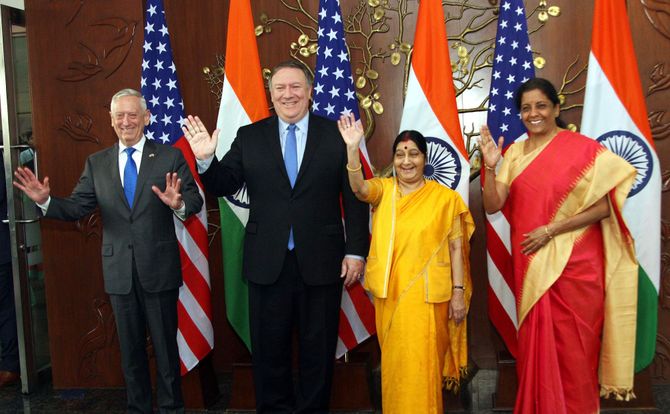Shifting alliances in South Asia
Tensions have run high in South Asia, where the interests of China, India, and Pakistan clash. Lately, Beijing and Islamabad have stepped up cooperation, while India and the U.S. have grown closer. The region faces many unsettled conflicts. Nuclear deterrence is stabilizing the situation – but as pressure grows, its efficacy may weaken.

The triangle of China, India and Pakistan is a region where tensions are high. Ever since the mismanaged and partially forced creation of India and Pakistan when the subcontinent gained its independence from the United Kingdom, the two countries have been at odds, fighting four wars against each other – three over the division of Kashmir. At the border between China and India, there are still disputed territories. These two powers have also waged war against each other. Today, areas of conflict remain.
Both China and India have become more assertive in recent decades. China is challenging the United States for global hegemony and believes it is entitled to Asian predominance. India claims the role of leading power in South Asia, the southern flank of the Himalayas and especially the Indian Ocean.
Historically – mainly during the Cold War – India saw itself as leader of the nonaligned nations, though it leaned toward the Soviet side. Pakistan was an ally of the U.S.
New alliances
Lately this has changed. As China’s influence has risen, the U.S. and India have grown closer. The Americans pivoted toward India mostly due to the countries’ mutual interest in containing China. Neither power wants the Chinese presence in the Indian Ocean to get any stronger.
Chiefly due to U.S. sensitivity regarding Pakistan’s policies toward Afghanistan, relations between those two nations cooled. This gave China a tremendous opportunity to access the Indian Ocean through Pakistan and western China. China’s interests are manifold: its less-developed western regions obtain access to the sea, it gains an additional inroad to the Indian Ocean and it allies itself with one of India’s main rivals.
The BRI might look like a boost to Pakistan’s economy, but will result in political and economic dependence on Beijing.
In this context, China is establishing the China-Pakistan Economic Corridor, a branch of its huge Belt and Road Initiative (BRI). It will include railways and highways across the Himalayas, through Pakistan to the port of Gwadar, which China is developing on the coast of the Arabian Sea. On the surface, this might look like an advantageous boost to Pakistan’s economy, but the result will be increased debt to China, as well as more political and economic dependence.
Nepal is situated on the southern flank of the Himalayas and is open to India’s heartland. Previously, Nepal’s politics and economy had been strongly dominated by India. Today, China is courting Nepal, improving roads between the two countries and offering access to its ports. China may thus develop another ally on India’s border.
Charm offensive
The U.S. is trying to counteract China’s efforts. Last week U.S. Secretary of State Mike Pompeo and Chairman of the Joint Chiefs of Staff Gen. Joseph Dunford visited Pakistan. The countries agreed to “reset” the relationship and reached an understanding that the Trump administration and the new Pakistani government would try to meet each other’s expectations. Just a few days earlier, President Trump had canceled $300 million in military aid to Pakistan. Pakistan’s new prime minister, Imran Khan, had taken office only a couple of weeks prior.
The U.S. and India have finalized defense pacts that could bring their militaries closer amid growing Chinese influence.
The next day, Secretary of State Pompeo and Defense Secretary Jim Mattis met their Indian counterparts in New Delhi and finalized defense pacts that could bring their militaries closer amid growing Chinese influence across Asia.
The countries are considering carrying out a major joint military exercise, and the U.S. will support India’s construction of another aircraft carrier. Washington will also refrain from taking any measures against India for importing Iranian oil, suggesting only that New Delhi should reduce the quantity. In contrast to Washington’s actions toward Turkey, Secretaries Pompeo and Mattis did not threaten India for its plans to purchase an S-400 air-defense system from Russia. This shows how important it is for Washington to keep India on its side.
Just after Secretary Pompeo’s departure, Chinese Foreign Minister Wang Yi visited his Pakistani counterpart Shah Mahmood Qureshi. Islamabad confirmed that the China-Pakistan Economic Corridor remains a top priority under Prime Minister Khan. Mr. Wang and Mr. Qureshi both emphasized the value of the corridor for Pakistan, potentially sending a message to Washington.
Nuclear deterrent
The tensions between India, Pakistan and China are explosive. India has disputed territories with both of the other two countries. Indian Prime Minister Narendra Modi has followed Hindu nationalist policies, which tend to alienate India’s 170 million Muslims and therefore provoke Pakistan, an Islamic republic. China has the superior military by far, and claims that the northeastern Indian state of Arunachal Pradesh – with some 1.3 million inhabitants – is rightfully Chinese territory.
However, a clash is more likely to occur between India and Pakistan, with Beijing supporting Islamabad. In consequence, Washington would step in on New Delhi’s side. That all these countries are nuclear powers actually stabilizes this situation somewhat – for the moment. As tensions rise, this factor could lose strength as a deterrent.
